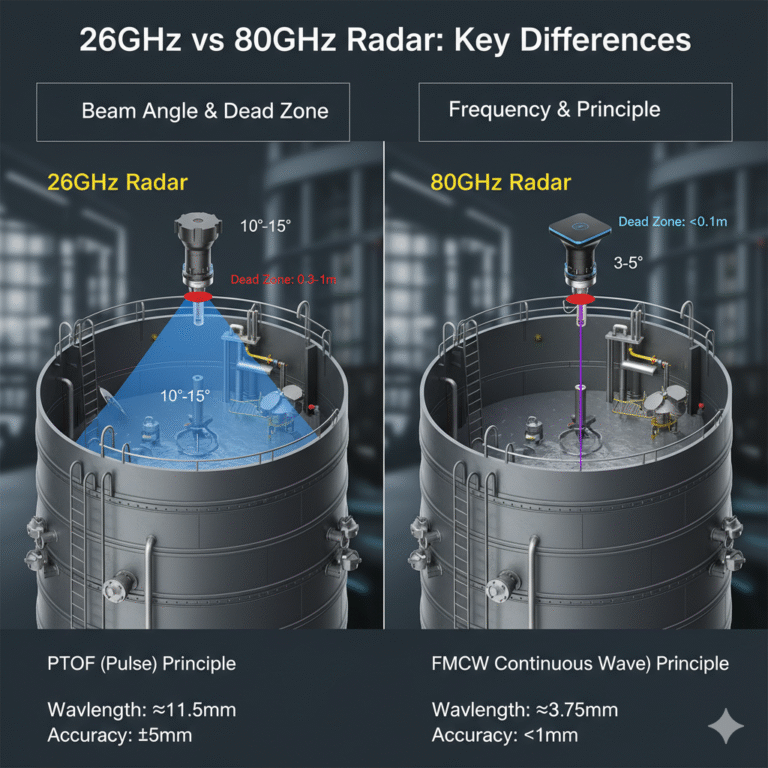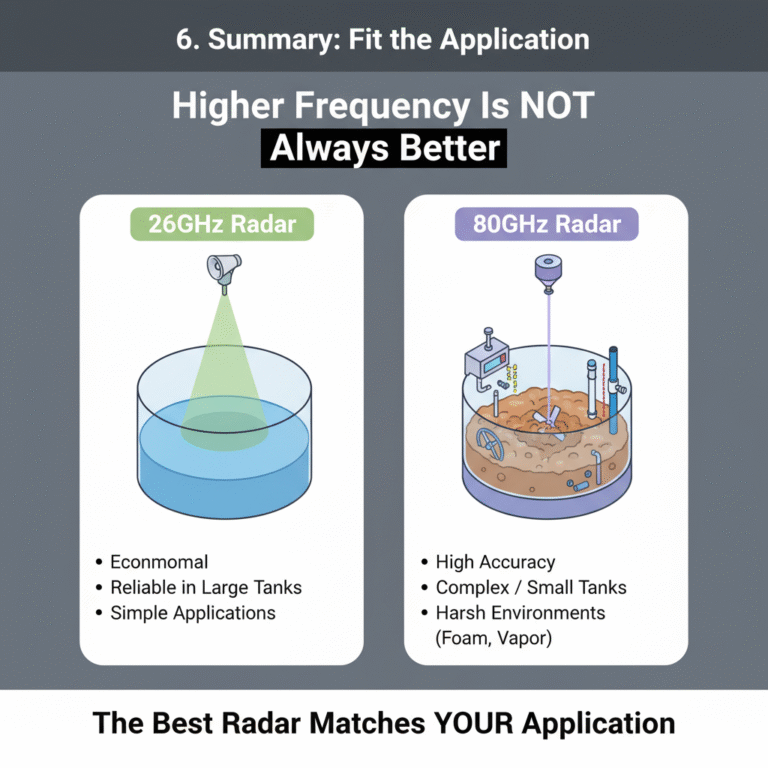Radar level transmitters have become one of the most reliable technologies for liquid and solid level measurement. With advantages such as non-contact measurement, high accuracy, strong anti-interference capability, minimal maintenance, and long service life, radar instruments are now widely used across process industries.
Among various radar frequencies—6GHz, 26GHz, 80GHz, and even 120GHz—the 26GHz and 80GHz models are the most commonly compared. Although both belong to the microwave radar family, their operating principles and performance differ significantly due to frequency, wavelength, beam angle, and antenna design.
This article provides a clear, practical comparison to help you select the right type for your application.

1. Frequency & Wavelength: The Foundational Difference
Microwaves span from 300MHz to 300GHz, with wavelengths from 1m to 1mm. Based on frequency, they are divided into:
Decimetre waves: 300MHz–3GHz
Centimetre waves: 3–30GHz
Millimetre waves: 30–300GHz
Frequency and wavelength are inversely related:
c = λf (speed of light = wavelength × frequency).
26GHz Radar
Operating frequency: 24–26GHz
Wavelength: ≈11.5 mm
Falls within the centimetre-wave band
80GHz Radar
Operating frequency: 78–82GHz
Wavelength: ≈3.75 mm
Falls within the millimetre-wave band
Shorter wavelength = better focusing ability and higher resolution, which is a key reason why 80GHz performs better in complex environments.
2. Measurement Principle: PTOF vs FMCW
26GHz — Pulse Time-of-Flight (PTOF)
26GHz radars typically use pulse radar technology.
The transmitter emits very short high-frequency pulses; the reflected signal is received after bouncing off the surface. The instrument calculates distance based on:
Distance = (c × Δt) / 2
Features:
Mature technology
Lower cost
Limited by pulse width → larger dead zone (typically 0.3–1m)
Lower resolution (≈±5 mm)
Suitable for applications where extremely high precision is not required.
80GHz — Frequency Modulated Continuous Wave (FMCW)
80GHz radars operate on FMCW technology, emitting continuous waves whose frequency changes linearly over time. When the reflected wave returns, its frequency differs from the transmitted wave.
The frequency difference (Δf) is proportional to distance:
Δf ∝ Distance
Advantages:
Very small dead zone (often < 0.1m)
High resolution (≈±1 mm)
Strong anti-interference capability
Excellent in near-range or complex conditions
FMCW radar is now the mainstream solution in high-precision and advanced process applications.

3. Beam Angle: The Key to Performance in Complex Tanks
Beam angle determines the radar’s ability to avoid disturbances such as tank walls, coils, agitators, and ladders.
Typical Beam Angles
26GHz: 10°–15°
80GHz: 3°–5°
This gives 80GHz a major advantage:
Narrow beam = better focusing
Minimal reflection from obstacles
Ideal for narrow tanks, small nozzles, or crowded internal structures
4. Antenna Type & Interference Resistance
80GHz Radar
Often uses planar microstrip or lens antennas, which provide:
Strong resistance to steam, dust, foam, condensation
Stable signals even in harsh environments
Superior performance in agitated tanks, where swirling surfaces or foam are common
26GHz Radar
Mostly uses horn antennas, which:
Are robust and proven
Perform well in standard conditions
Are less effective in environments with heavy dust, strong vapor, turbulence, or obstructions

5. How to Select: 26GHz or 80GHz?
Situations where 80GHz is the Best Choice
✔ Tanks with agitators, coils, ladders, or heating pipes
✔ Small tanks / vessels with limited space (nozzle < 1m)
✔ Mediums with foam, vapor, condensation, or low dielectric constant
✔ Applications requiring high precision (batching, custody transfer)
✔ When installation length is limited (short nozzles)
✔ Solid measurement — powders, pellets, grains
80GHz provides the highest reliability in challenging environments.
Situations where 26GHz is More Suitable
✔ Large standard storage tanks (water, wastewater, crude oil, chemicals)
✔ Budgets are tight and accuracy requirements are moderate
✔ Mediums with good reflection characteristics (εr high)
✔ Applications without internal obstacles or disturbances
26GHz remains cost-effective and stable for straightforward applications.

6. Summary: Higher Frequency Is Not Always Better — Fit the Application
80GHz radar offers:
Smaller beam angle
Higher accuracy
Smaller dead zone
Better performance in complex, small, or harsh environments
While 26GHz remains:
Mature
Economical
Reliable in simple and large-tank applications
The correct choice depends on process complexity, accuracy requirements, installation conditions, medium properties, and project budget.
The best radar is the one that matches your application—not necessarily the highest frequency.
